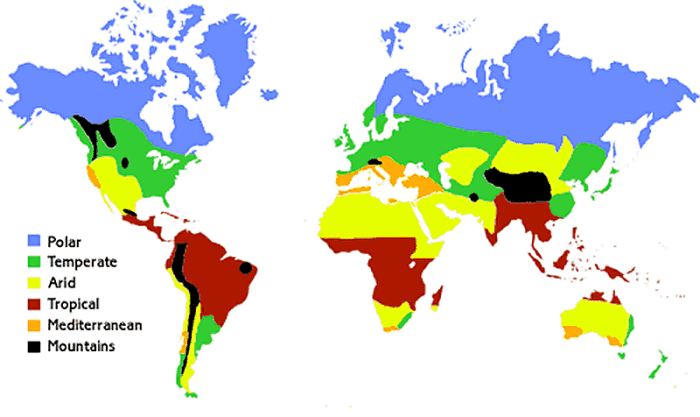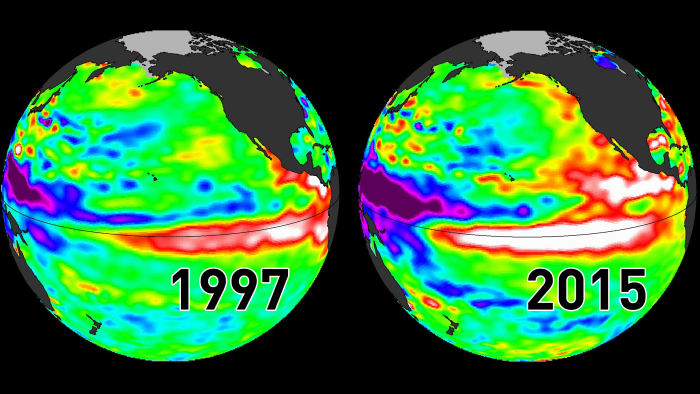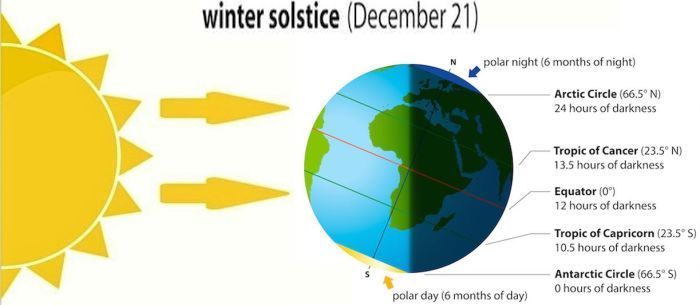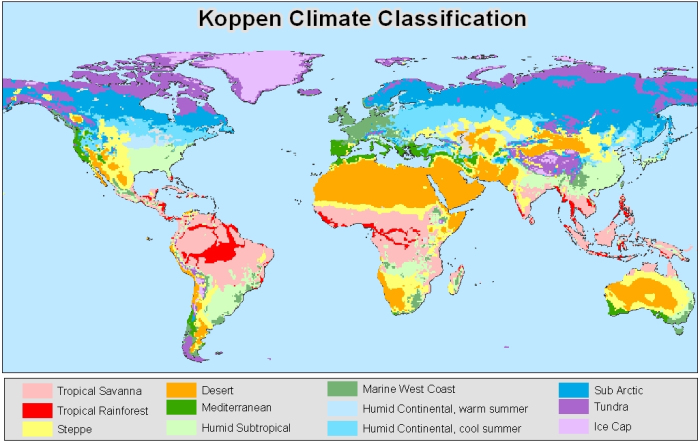Climatic zones
Climatic zones
In this chapter I’m going to explain what the climate is, and what factors depend on it. Then I will talk about the difference between climate, weather and seasons, and the relationships between them. The climate and its classification is an exciting topic.
Introduction to the subject of climate
I’ve noticed that travellers more or less know what weather they can expect when they get to their destination but hardly anyone ever knows what kind of climate it is. For this reason I would like to give a basic explanation of climate and what it depends on and afterwards I’m going to explain the difference between climate, weather and seasons and relationships between them. My intention is to present all the definitions in a very simple and descriptive way so that persons who are not strong in this area could also like this subject.
At the end I’m also going to say a few words about the extremely important Köppen climate classification.
Climate
Have you ever wondered why in certain parts of the planet Earth we have deserts and in others there are glaciers or tropical forests? Have you ever wondered why specific regions of the globe are inhabited by certain species of animals and plants? The answer to these questions is climate because this is what determines the above relationships. Climate is determined on the basis of statistical weather patterns, typically over 30 years but also longer. Factors taken into account are variability of air temperature, humidity, atmospheric pressure, wind, precipitation, the length of days and nights and many other meteorological factors in a given area over a long period of time.
Under the definition of climate are also taken record temperatures and record rainfalls what means that when we hear on the radio that “today we have the highest temperature for 20 years” they talk about climate which is the average weather data from a long period of time. Climate also includes extremes weather conditions such as hurricanes, floods, droughts, fires, heat waves and more. That’s why for example in Bangladesh and the Philippines there are regular floods and hurricanes, in Australia there are heat waves and fires and in North Africa regular droughts. Based on decades of meteorological research we can predict that in specific regions of the world we can expect specific weather extremes.

The climatic zones map.

The two main factors which determine climate are precipitation and air temperature, although there are a few more:
- The first thing is latitude. Temperature rises the closer we are to the equator and decreases the further we are from it. Sun rays strike the equator at an angle of 23 degrees north and 23 degrees south latitude. Sunlight is then spread on a very large area and the poles are always the coldest because sun rays have the longest way to travel from the equator. For this reason, in the poles during during the summer months the sun does not set at all but in the winter months it doesn’t rise. On the other hand on the equator and near it the length of the day is not much different.
- Climate also depends on height. Earth is a rough, mountainous and grooved structure. Shortly speaking, the higher the colder it is because the air is more rarefied and thus it can not accumulate heat so easily.
- Winds also play a crucial role. If hot and dry winds blow from a hot desert the air temperature will rise but when freezing and wet winds blow from the North Atlantic it will be obviously colder.
- Ocean currents raise and lower the temperature because they act as conveyor belts carrying hot water and rain from the equator to the poles and cold water from the poles to the tropics. Thus ocean currents regulate the global climate because they help counteract the uneven distribution of solar radiation reaching the Earth’s surface.
- Continentality; means the distance of seas and oceans to land masses. Coastal areas are cooler and more humid than the ones inland. Central areas far away from oceans and seas are subject to large temperature differences. The summer months are usually very hot and dry because moisture evaporates from the sea before it reaches the central land mass.
- In addition to natural factors shaping the climate we can’t forget the human activity. With the rapid increase of world population and the development of industry people have became poisoners, what means that we are the only species affecting the climate. Millions of cars and factories emit carbon dioxide and other harmful gases into atmosphere. Along with demand for wood the situation got even worse because trees absorb carbon dioxide and produce oxygen. As a result the increased demand for transport with fewer trees do not only poison more but has also bad effect on climate. My critics might say that I am talking only about pollution but climate (statistical weather data from many decades) will also change in certain places, because in the largest cities (Delhi, Beijing) among the exhausts of millions of cars and close to the chimneys of factories it is always hotter than it would be without them.
For example one day in Delhi is equal to smoking 20 cigarettes and in Beijing about 40. Every year in China only because of air pollution 4000 people die. I give this information to show the fact that air pollution has become a part of atmosphere what means that at least for that reason people have impact on climate. Then after 30 years of research on cities in India or China the researchers would conclude that the climate in certain regions has changed (without giving a reason) but I can say even without testing that if India and China turned off all of their factories and cars, climate in the most urbanized areas would change again. The air temperature also increases because of tall buildings because if wind can’t move freely (Hong Kong) it can’t disperse harmful gases and makes breathing more difficult. For that reason Hong Kong leads in the field of heart attacks and respiratory infections. Many species of animals that could live there are also removed from the affected areas, not only because of destruction of their habitat but also because the climate in many large cities and in the vicinity of large factories got warmer. I therefore believe that once in 100 years we need an outbreak that would cleanse the planet’s most populous continents.
Climate change
My thesis is therefore that climate change is not a global phenomenon and almost apocalyptic as it is shown us by the media but it is strictly local, fully reversible and controlled.
I would also like to point out that I do not have the means to check if climate change, so heavily advertised in the media, is true on a global scale or whether it is just another global profit making hysteria to” protect climate”, but really the money for this purpose is spent on Luciferian goals. Greenhouse gases surely have impact on climate in large industrial and at the same time the most primitive cities. When however I watch the growing population of polar bears and still severe winters in the world, I doubt that ‘climate change’ on a global scale, in a way in which the media presents us is real. For those reasons I am skeptical about ‘climate change’.
According to me it could be a great deception designed to extort money and used as a distraction from the important things, such as for example: the Great Replacement Project in traditionally white countries, crimes of the globalists, wars, or artificial fueling of inflation and poverty in the world at the expense of stunned masses. Each time the elites who rule politicians do something straight from hell, we always hear heartbreaking stories that are simply not true.
Weather
Weather is the state of the atmosphere, meaning that at the particular time and place is either hot or cold, rainy or dry, calm or cloudy and stormy. In other words let’s try to think about it in the following way: climate is what we expect on the basis of long-term meteorological research while weather is short-term, what means that it is what we can see through the window on that specific day. For example, in mid-June in Warsaw Poland the average air temperature is about 23°C and it is usually sunny. This is our climate. However, just this year in mid-June in Warsaw at a given time it is only 15°C and there is strong wind. This is our weather, which may be, but doesn’t have to be the exception to the routine which we expect. Besides, weather is like a woman because it tends to change very quickly.

El Nino.
When writing about weather it is worth to mention about the weather phenomenon called El Nino, based on maintaining higher than average surface water temperatures in the equatorial Pacific. Although El Nino occurs mainly in the Pacific it affects the climate worldwide as the masses of warm and cold water circulate through the entire global ocean; and when the direction changes in one place it changes everywhere. El Nino is responsible for weather extremes what means that arid regions experience heavy rains and humid regions experience droughts. If El Nino hits during favourable seasons it can cause floods, winter may be colder and summers drier and hotter. The opposite of El Nino is La Nina, which is characterized by lower than average water temperatures.
I have purposely placed El Nino in the “weather” chapter rather than in the “climate” chapter because according to me this is an irregular and short – term occurrence appearing approximately every 3 to 6 years and having impact only on weather. Some “experts” call El Nino a “climatic phenomenon” and not a weather phenomenon because they try to convince us that it has an impact on the “climate change”, at the same time denying the basic definition of climate as a long-term and routine weather changes. El Nino would be a climatic phenomenon if it hit at least 4 times a year during every season, but it doesn’t.
Seasons
Another very important factor of climate are the seasons which are differently distributed over time in different parts of the planet. The planet Earth spins around its axis at the angle of 23.5 degrees and this inclination associated with solar radiation determines the seasons. Where there is a radiation at an angle of 90 degrees the temperatures are the highest but when the radiation is at a lesser angle it is always colder.

Summer solstice.
In other words season (spring, summer, autumn and winter) is one of four time periods reflecting different weather patterns and daily hours of sunlight resulting from rotation of the Earth in relation to the sun (picture above). Each of the seasons, for example in the temperate climate has its own distinctive look, different weather and special behavior of plants and animals. Summer is the warmest and during that time plant growth is the richest but in winter some animals go into hibernation and others migrate. Due to the rotation of the Earth at an angle of 23.5 degrees and a heating sun the hottest months in the northern hemisphere are June, July and August while in the southern hemisphere the hottest months are December, January and February. As a result this means that in Australia or Argentina winter begins in June, while in England or Poland it is the beginning of summer.
The further we go north the greater the differences in the length of daylight and a very good example is Scandinavia. During summer Helsinki has 18.5h daylight but in winter only 6h. However, in southern Europe this difference is smaller because for example in Cyprus the difference between summer and winter is 14.5h to 9h. For example in Svalbard in Norway sun doesn’t set from the 19th of April to the 13th of August and in the town of Barrow in Alaska the sun does not set at all from mid-May to early August. On the other hand there is absolute darkness in Barrow from mid-November to January for about 51-67 days.
Extreme regions of the Earth are the poles because depending on the rotation of our planet in relation to sun when the North Pole has six months of daylight the South Pole is plunged into darkness also for 6 months, and then vice versa. On the other hand places located close to the equator do not have any real differences in the length of daylight and darkness and they remain warm throughout the year. A country such a Singapore for example which is located 137km north of the equator is therefore hot and humid throughout the year.

Winter solstice.
To sum up depending on the climate in a given region (first map) there are obviously huge differences in appearance of each season. In a temperate climate there is a greater diversity in the appearance of specific seasons and a good example of it is Poland; with its warm springs, hot summers, cool and yellow autumns and cold winters, while in places such as for example Saudi Arabia, apart from air temperature all seasons look the same because it is hot and dry whole year round.
For example in hot regions we don’t distinguish between traditional 4 seasons but the the rainy season (monsoon, such as in Malaysia), dry season (India) and in tropical regions also the cool season. In some parts of the world different seasons are distinguished in other ways because names of those seasons relate to climatic extremes, such as: tornado season and a flood season (Philippines, Bangladesh) fire season (Australia) and hurricane season; and for farmers there are seasons of planting and harvest. Therefore to summarize, the traditional 4 seasons of the year and seasons in different parts of the world are very different from each other because they depend on their climates .
Köppen climate classification
Köppen climate classification is one of the most widely used climate classification systems. For the first time it was published by the Russian – German climatologist Wladimir Köppen in 1884, with a few amendments done by Köppen in 1918 and 1936. Later, the German climatologist Rudolf Geiger worked with Köppen on changes in the classification system, that’s why sometimes this division is called the Köppen – Geiger classification system.
The system is based on the concept that native vegetation is the best expression of climate. Thus, the boundaries of climatic zones were selected in view of the distribution of vegetation. This classification combines the average temperature, annual precipitation and monthly and seasonal rainfall. In 1960 Trewartha climate classification was created which could be considered a modified Köppen classification because it approached climate in a more detailed way with regard to the middle climate zones latitude and it took into account the native vegetation. For example in the Köppen classification London and Brisbane are in the same climate zone despite the fact that seasonal temperature and vegetation are significantly different. In my article I am presenting a well known and widely used Köppen classification.

The Köppen climate classification.
I, in my article present a well known and widely used Köppen classification (map above), which is divided into 5 basic groups (A, B, C, D, E) and where each group contains several climatic sub-types. Because the Köppen climate classification is well known and common I’m only going to show types and sub-types but I’m not going to describe them because the description would be so extensive that it would exceed the general knowledge about the climate.
Persons who are interested in accurate knowledge of the sub-types of climates I recommend scientific sources where they can find information on annual and seasonal temperatures, rainfall, vegetation and animal habits which also explain a lot. I assure you however, that this would be just the beginning because climate is also affected by stratosphere, but to discuss this topic first we would have to know chemistry at a high level. As we can see the adventure with climate is a story that can last for a very long time and that requires exploration in many disciplines of science.
A. Tropical climate
- rain forest
- monsoon
- savanna
B. Dry climate (arid and semi – arid)
- desert (hot, cold)
- steppe (semi-dry), hot and cold.
C. Temperate climate
- dry – summer or Mediterranean
- subtropical
- sea moderate or ocean
- maritime temperate or oceanic
- moderate highland with dry winters
- dry summer maritime or sub – alpine
D. Continental climate
- hot summer continental
- warm summer continental
- sub – arctic continental or boreal (taiga)
- continental sub – arctic with very harsh winters
E. Polar and alpine climate
- tundra
- ice cap
The summary of climate
Perhaps according to some people I’ve gone too much into detail but in this brief way I wanted to explain the meaning of climate, weather and seasons and I also introduced the very important introduction to the classification of climates. At the end, I think that giving climatic wishes would be not thought out, so I at least want to wish all travellers good weather.
Martin




























